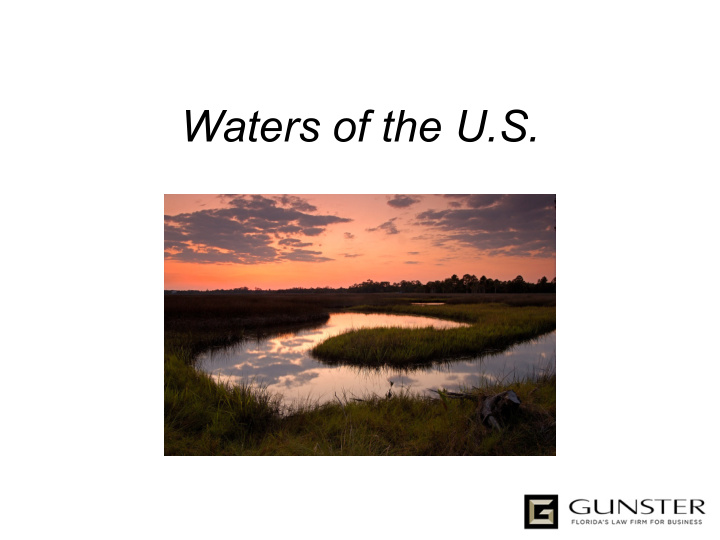



¡ ¡ ¡ ¡ ¡ ¡ ¡ ¡ Waters of the U.S.
Old WOTUS Rule Waters of the United States means: (1) All waters used in interstate or foreign commerce, including all waters subject to the ebb and flow of the tide; (2) All interstate waters, including interstate wetlands (3) All “other waters” the use, degradation or destruction of which could affect interstate or foreign commerce (4) All impoundments of waters otherwise defined as waters of the United States (5) Tributaries of (1) – (4) (6) The territorial seas (7) Wetlands adjacent to/neighboring (1) – (6)
Proposed WOTUS Rule (1) All waters used in interstate or foreign commerce, including all waters subject to the ebb and flow of the tide; (2) All interstate waters, including interstate wetlands; (3) The territorial seas; (4) All impoundments of waters; (5) “Tributaries” of (1)-(3) (6) Waters, including wetlands, adjacent to/“neighboring” (1)-(5) (7) Special waters with a “significant nexus” (8) Floodplain or Near High Tide Waters with a “significant nexus” New Definitions: Tributary, Neighboring, Significant Nexus (3) All “other waters” the use, degradation or destruction of which could affect interstate or foreign commerce (4) All impoundments of waters otherwise defined as waters of the United States (5) Tributaries of (1) – (4) (6) The territorial seas (7) Wetlands adjacent to/neighboring (1) – (6)
New WOTUS Rule WOTUS Y Y Significant Categorically In Categorically Nexus ((a)1-6)? Out (b)? N N ((a) 7-8)? Y N Ditches are Not WOTUS Special
Categorical Inclusions (1) All waters used in interstate or foreign commerce, including all waters subject to the ebb and flow of the tide; (2) All interstate waters, including interstate wetlands; (3) The territorial seas; (4) All impoundments of waters; (5) Tributaries of 1-3; (6) Waters, including wetlands, adjacent to/“neighboring” (1)-(5)
Tributaries • Water with a bed, a bank, and a ordinary high water mark which contributes flow directly or indirectly to a water in (1)-(3), or even without a bed, bank, or OHWM if they contribute flow to water in (1)-(3). • BUT , a water doesn’t lose its tributary status if for any length there are one or more man-made breaks (such as culverts or dams) or natural breaks (such as wetlands) so long as a bed, bank and OHWM can be identified upstream of the break. • BUT , a tributary can be natural, man-altered, or man- made and includes ditches not excluded elsewhere. • If a ditch meets a categorical exclusion it is NOT a WOTUS, no matter what.
Adjacent • Adjacent means bordering, contiguous or neighboring (existing definition); • Neighboring means: • All waters located within 100’ of OHWM of waters in (1)-(5); • All waters located within 100-year floodplain of waters in (1)-(5) and not more than 1500’ from OHWM of such water; • All waters within 1500’ of the high tide line of a water in (1)-(3)
Categorical Exclusions • Waste Treatment Systems, including treatment ponds and lagoons • Prior converted cropland, as determined by EPA • Ditches: • Ephemeral Flow ditches • Intermittent Flow ditches, unless it drains a wetland • Ditches that do not contribute flow, either directly or indirectly to a What is water in (1)-(3) • The following: Dry o Artificially irrigated areas that would revert to dry land should irrigation stop; Land? o Artificial lakes and ponds, including farm and stock watering ponds, irrigation ponds, settling basins, and cooling ponds; o Groundwater; o Puddles; o Stormwater control features created in dry land; and o Wastewater recycling structures constructed on dry land, including retention basins, recharge basins, percolation ponds, and water distributary structures.
Significantly Nexable Waters 1. Prairie Potholes, Carolina and Delmarva Bays, Pocosins, Western Vernal Pools, Texas Coastal Prairie Wetlands with a significant nexus to a (1)-(3) water; and 2. All waters within the 100-year floodplain of a (1)-(3) water and all waters located within 4,000 of the high tide line or OHWM of a (1)-(5) water.
Significant Nexus • Water that alone or in combination with out similarly situated waters in the region significantly affects the chemical, physical, or biological integrity of a (1)-(3) water that is not speculative or insubstantial. • Similarly Situated Waters are those that are sufficiently alike and are sufficiently close. • Factors for evaluating significant nexus: • Sediment trapping • Nutrient recycling • Pollutant trapping, transformation, filtering, and transport • Retention and attenuation of flood waters • Runoff Storage • Contribution of flow • Export of organic matter • Provision of life cycle dependent habitat
My Opinion Florida = 100 year flood plain 100 year flood plain = significant nexus Significant Nexus = WOTUS Florida = WOTUS Similarly Situated • You get a JD when your neighbor gets a JD • Legally questionable Exclusions CRITICAL Substantial Changes to Rule From the Draft • Potentially acceptable with another round • Legally questionable Lots of room for professional judgment
Going Forward • Effective Date: August 28, 2015 • Permits or J.D. that are issued AFTER that date will be under new rule • Legal Challenges filed • Rule is effective despite legal challenge
Recommend
More recommend